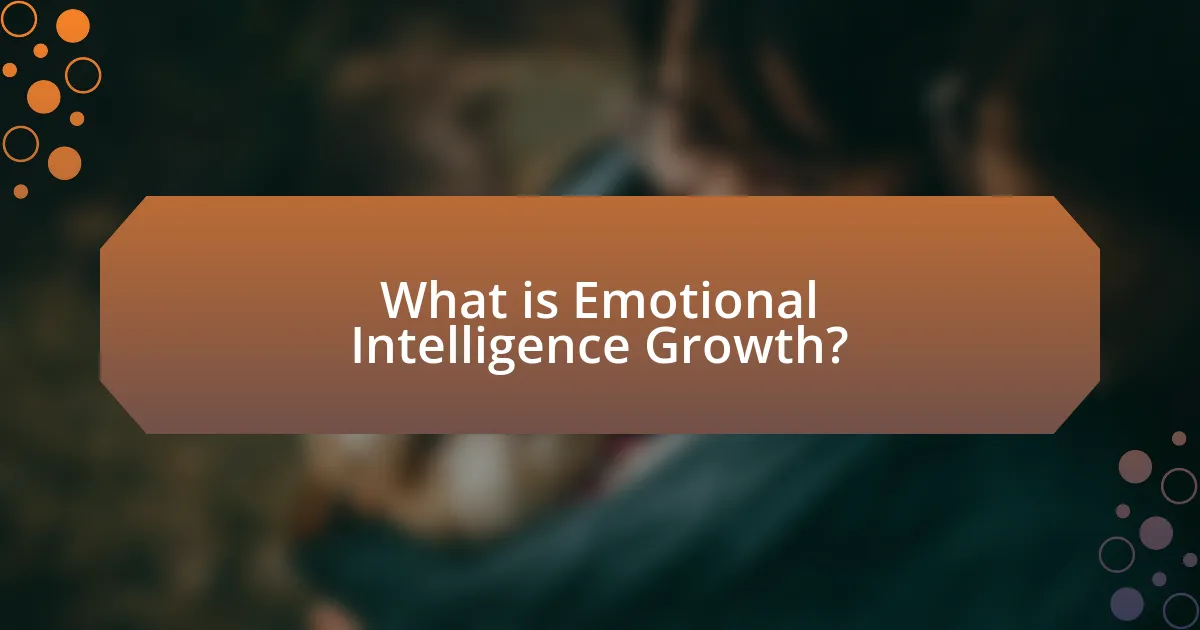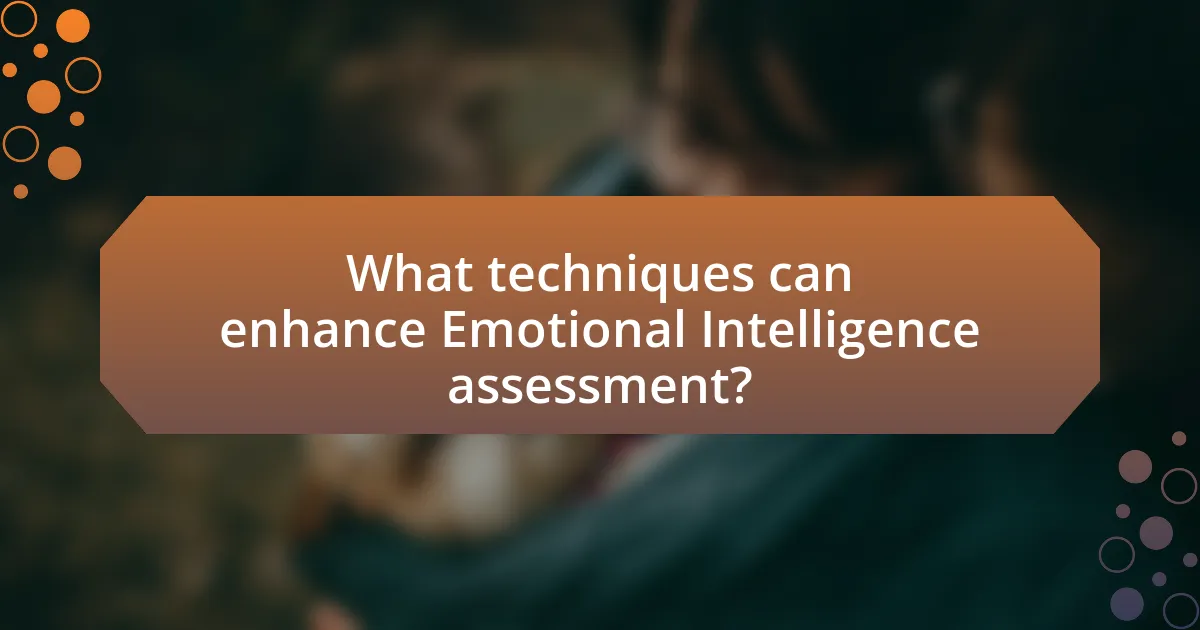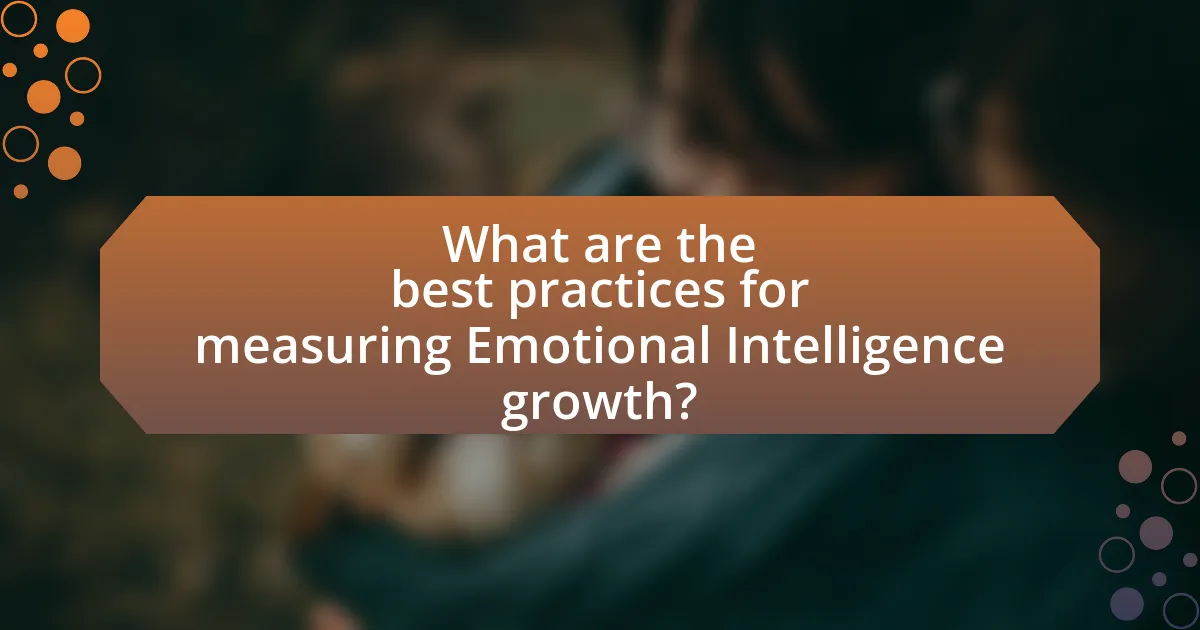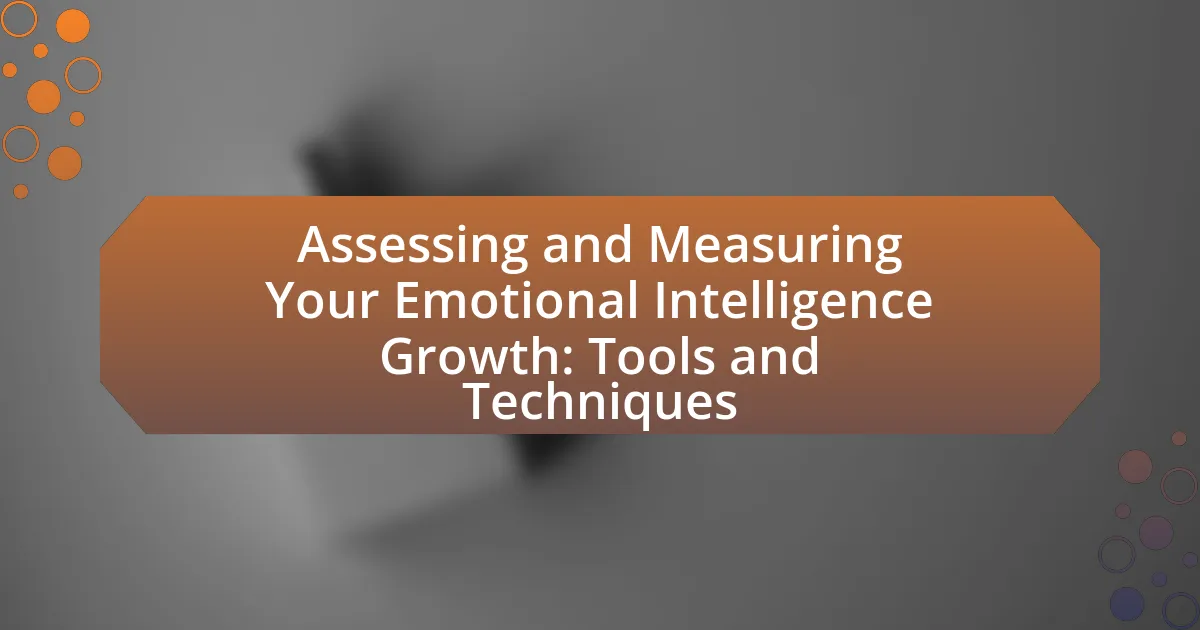Emotional Intelligence Growth encompasses the development of an individual’s ability to recognize, understand, and manage their own emotions and those of others. This article outlines the definition of emotional intelligence, its key components, and its significance for personal development. It also discusses various assessment tools, such as the Emotional Quotient Inventory (EQ-i) and the Mayer-Salovey-Caruso Emotional Intelligence Test (MSCEIT), along with techniques for measuring improvements in emotional intelligence. Additionally, the article highlights the importance of self-reflection, feedback, and practical strategies for tracking emotional intelligence growth over time.

What is Emotional Intelligence Growth?
Emotional Intelligence Growth refers to the development and enhancement of an individual’s ability to recognize, understand, and manage their own emotions, as well as the emotions of others. This growth can be measured through various tools and techniques, such as self-assessments, feedback from peers, and emotional intelligence training programs. Research indicates that individuals with higher emotional intelligence tend to have better interpersonal relationships, improved mental health, and greater professional success, as evidenced by studies showing that emotional intelligence is a strong predictor of workplace performance.
How is Emotional Intelligence defined?
Emotional Intelligence is defined as the ability to recognize, understand, and manage one’s own emotions while also being able to recognize, understand, and influence the emotions of others. This concept encompasses skills such as emotional awareness, empathy, and emotional regulation. Research by Daniel Goleman, a prominent psychologist, highlights that individuals with high emotional intelligence tend to have better interpersonal relationships and are more successful in both personal and professional settings.
What are the key components of Emotional Intelligence?
The key components of Emotional Intelligence are self-awareness, self-regulation, motivation, empathy, and social skills. Self-awareness involves recognizing one’s emotions and their impact on thoughts and behavior. Self-regulation refers to managing emotions and impulses effectively. Motivation encompasses the drive to achieve goals for personal reasons beyond external rewards. Empathy is the ability to understand and share the feelings of others, which enhances interpersonal relationships. Social skills involve the ability to manage relationships and navigate social networks effectively. These components are supported by research from Daniel Goleman, who identified them as essential for effective emotional functioning in both personal and professional contexts.
Why is Emotional Intelligence important for personal development?
Emotional Intelligence is crucial for personal development because it enhances self-awareness, self-regulation, and interpersonal skills. These components enable individuals to understand their emotions and the emotions of others, leading to better decision-making and improved relationships. Research indicates that individuals with high emotional intelligence are more likely to succeed in both personal and professional settings, as they can navigate social complexities and manage stress effectively. For instance, a study published in the Journal of Organizational Behavior found that emotional intelligence is a significant predictor of job performance and leadership effectiveness, highlighting its importance in personal growth and development.
What does it mean to assess Emotional Intelligence growth?
Assessing Emotional Intelligence growth means evaluating an individual’s ability to recognize, understand, and manage their own emotions as well as the emotions of others. This assessment typically involves using standardized tools, such as self-report questionnaires or 360-degree feedback mechanisms, to measure competencies like emotional awareness, empathy, and emotional regulation. Research indicates that effective assessment can lead to improved interpersonal skills and better workplace performance, as demonstrated in studies showing that higher emotional intelligence correlates with enhanced leadership abilities and team dynamics.
How can one measure improvements in Emotional Intelligence?
One can measure improvements in Emotional Intelligence (EI) through various assessment tools and self-reflection techniques. Standardized EI assessments, such as the Emotional Quotient Inventory (EQ-i) and the Mayer-Salovey-Caruso Emotional Intelligence Test (MSCEIT), provide quantifiable scores that reflect an individual’s emotional abilities and can be retaken over time to track progress. Additionally, self-assessment questionnaires and 360-degree feedback from peers and supervisors can offer insights into behavioral changes and interpersonal effectiveness, which are key components of EI. Research indicates that individuals who engage in regular EI assessments show significant improvements in emotional regulation and interpersonal relationships, validating the effectiveness of these measurement tools.
What are the indicators of Emotional Intelligence growth?
Indicators of Emotional Intelligence growth include improved self-awareness, enhanced emotional regulation, better empathy, and stronger interpersonal relationships. Self-awareness manifests as an increased ability to recognize and understand one’s emotions and their impact on thoughts and behaviors. Emotional regulation is evident when individuals can manage their emotional responses effectively, leading to less impulsive reactions. Enhanced empathy is shown through a greater capacity to understand and share the feelings of others, which fosters deeper connections. Finally, stronger interpersonal relationships are a clear indicator, as individuals with higher emotional intelligence tend to communicate more effectively and resolve conflicts more constructively. These indicators are supported by research indicating that emotional intelligence correlates with better mental health, job performance, and leadership skills.
What tools are available for assessing Emotional Intelligence?
Various tools are available for assessing Emotional Intelligence, including the Emotional Quotient Inventory (EQ-i), the Mayer-Salovey-Caruso Emotional Intelligence Test (MSCEIT), and the Trait Emotional Intelligence Questionnaire (TEIQue). The EQ-i measures emotional and social functioning through self-reporting, while the MSCEIT evaluates emotional intelligence through performance-based tasks. The TEIQue assesses personality traits related to emotional intelligence. These tools are widely recognized in psychological research and practice, providing reliable metrics for understanding and developing emotional intelligence.
What are the most popular Emotional Intelligence assessment tools?
The most popular Emotional Intelligence assessment tools include the Emotional Quotient Inventory (EQ-i), the Mayer-Salovey-Caruso Emotional Intelligence Test (MSCEIT), and the Six Seconds Emotional Intelligence Assessment (SEI). The EQ-i measures various aspects of emotional intelligence, such as self-perception and interpersonal skills, and has been widely used in both clinical and organizational settings. The MSCEIT evaluates emotional intelligence through a series of tasks that assess the ability to perceive, use, understand, and manage emotions, making it a scientifically validated tool. The SEI focuses on practical applications of emotional intelligence in everyday life and is often used in educational and corporate environments to enhance personal and professional development.
How do these tools differ in their approach and methodology?
The tools for assessing and measuring emotional intelligence differ primarily in their approach and methodology by varying their focus on self-reporting versus performance-based assessments. Self-reporting tools, such as questionnaires, rely on individuals’ perceptions of their emotional skills, often leading to subjective biases. In contrast, performance-based assessments, like situational judgment tests, evaluate emotional intelligence through real-life scenarios, providing objective data on how individuals respond to emotional challenges. Research indicates that self-report measures can be influenced by social desirability bias, while performance-based methods offer a more accurate reflection of emotional intelligence in practice, as evidenced by studies showing higher predictive validity for job performance (Schmidt & Hunter, 1998).

What techniques can enhance Emotional Intelligence assessment?
Techniques that can enhance Emotional Intelligence assessment include self-report questionnaires, 360-degree feedback, and behavioral observation. Self-report questionnaires, such as the Emotional Quotient Inventory (EQ-i), allow individuals to evaluate their emotional skills and awareness. 360-degree feedback involves gathering insights from peers, subordinates, and supervisors, providing a comprehensive view of an individual’s emotional competencies. Behavioral observation, often conducted in real-world settings, enables assessors to evaluate emotional responses and interactions in context. These methods collectively improve the accuracy and depth of Emotional Intelligence assessments by incorporating multiple perspectives and real-life behaviors.
How can self-reflection contribute to Emotional Intelligence growth?
Self-reflection significantly contributes to Emotional Intelligence growth by enabling individuals to assess their emotions, behaviors, and reactions in various situations. This process fosters self-awareness, which is a core component of Emotional Intelligence, allowing individuals to identify their emotional triggers and understand how their emotions affect their interactions with others. Research indicates that self-reflection practices, such as journaling or mindfulness, can enhance emotional regulation and empathy, leading to improved interpersonal relationships. For instance, a study published in the Journal of Personality and Social Psychology found that individuals who engage in regular self-reflection demonstrate higher levels of emotional awareness and better conflict resolution skills, thereby validating the positive impact of self-reflection on Emotional Intelligence development.
What questions should one ask during self-reflection?
During self-reflection, one should ask questions such as: “What are my core values?” and “How do my emotions influence my decisions?” These questions help individuals identify their guiding principles and understand the impact of their emotional responses on their behavior. Additionally, asking “What are my strengths and weaknesses?” allows for a clearer assessment of personal capabilities, while “What situations trigger my emotional responses?” aids in recognizing patterns in emotional reactions. Research indicates that self-reflection enhances emotional intelligence by fostering greater self-awareness and emotional regulation, which are critical components of emotional intelligence growth.
How can journaling aid in tracking Emotional Intelligence development?
Journaling aids in tracking Emotional Intelligence development by providing a structured method for individuals to reflect on their emotions, thoughts, and behaviors. This practice allows individuals to identify patterns in their emotional responses and social interactions, which are key components of Emotional Intelligence. Research indicates that reflective writing can enhance self-awareness, a critical aspect of Emotional Intelligence, by helping individuals articulate their feelings and reactions to various situations. For instance, a study published in the Journal of Personality and Social Psychology found that expressive writing can lead to improved emotional regulation and greater emotional insight, thereby supporting the development of Emotional Intelligence.
What role does feedback play in measuring Emotional Intelligence?
Feedback is essential in measuring Emotional Intelligence as it provides insights into an individual’s emotional awareness, regulation, and interpersonal skills. Specifically, feedback from peers, supervisors, and self-assessments can highlight areas of strength and opportunities for growth in emotional competencies. Research indicates that individuals who actively seek and utilize feedback demonstrate higher levels of emotional intelligence, as they are more adept at recognizing their emotional responses and understanding the emotions of others. For instance, a study published in the Journal of Organizational Behavior found that feedback mechanisms significantly enhance self-awareness, a core component of emotional intelligence, leading to improved emotional regulation and social skills.
How can one effectively solicit feedback from peers and mentors?
To effectively solicit feedback from peers and mentors, one should clearly articulate specific areas of interest or concern regarding their performance or emotional intelligence. This targeted approach encourages focused and constructive responses. For instance, asking for feedback on communication skills or conflict resolution can yield actionable insights. Research indicates that individuals who seek specific feedback are more likely to receive relevant and useful information, as highlighted in a study by Kluger and DeNisi (1996) in the “Psychological Bulletin,” which emphasizes the importance of specificity in feedback solicitation. Additionally, creating a safe and open environment for discussion fosters honest and candid responses, further enhancing the quality of the feedback received.
What are the best practices for interpreting feedback on Emotional Intelligence?
The best practices for interpreting feedback on Emotional Intelligence include actively listening to the feedback, reflecting on the insights provided, and seeking clarification when necessary. Actively listening ensures that the feedback is fully understood, while reflection allows individuals to assess how the feedback aligns with their self-perception and emotional responses. Seeking clarification helps to eliminate misunderstandings and provides deeper insights into specific behaviors or situations. Research indicates that individuals who engage in reflective practices are more likely to experience growth in their emotional intelligence, as they can identify patterns and areas for improvement.
How can Emotional Intelligence be assessed in real-life situations?
Emotional Intelligence can be assessed in real-life situations through observational assessments, self-report questionnaires, and performance-based measures. Observational assessments involve evaluating an individual’s behavior in social interactions, focusing on their ability to recognize and respond to emotions in themselves and others. Self-report questionnaires, such as the Emotional Quotient Inventory (EQ-i), allow individuals to reflect on their emotional skills and provide insights into their emotional awareness and regulation. Performance-based measures, like the Mayer-Salovey-Caruso Emotional Intelligence Test (MSCEIT), assess emotional intelligence through tasks that require individuals to identify, use, understand, and manage emotions effectively. These methods provide a comprehensive view of an individual’s emotional intelligence in practical contexts.
What scenarios can provide insight into one’s Emotional Intelligence?
Scenarios that can provide insight into one’s Emotional Intelligence include conflict resolution situations, team collaboration tasks, and feedback reception experiences. In conflict resolution, individuals demonstrate their ability to manage emotions and empathize with others, revealing their emotional awareness and regulation skills. Team collaboration tasks highlight how well individuals communicate, understand group dynamics, and respond to the emotions of team members, showcasing their social skills and relationship management. Feedback reception experiences allow individuals to assess their openness to criticism and ability to reflect on their emotional responses, indicating their self-awareness and adaptability. These scenarios collectively illustrate various dimensions of Emotional Intelligence, confirming its multifaceted nature.
How can role-playing exercises enhance Emotional Intelligence assessment?
Role-playing exercises enhance Emotional Intelligence assessment by providing a dynamic environment for individuals to practice and demonstrate their emotional skills in real-time scenarios. These exercises simulate interpersonal interactions, allowing participants to engage in role-specific behaviors that reveal their ability to recognize, understand, and manage emotions in themselves and others. Research indicates that experiential learning, such as role-playing, significantly improves emotional awareness and empathy, which are critical components of Emotional Intelligence. For instance, a study published in the Journal of Applied Psychology found that participants who engaged in role-playing showed a marked increase in their ability to empathize and respond appropriately to emotional cues compared to those who did not participate in such exercises.

What are the best practices for measuring Emotional Intelligence growth?
The best practices for measuring Emotional Intelligence (EI) growth include utilizing validated assessment tools, conducting self-reflections, and seeking feedback from peers. Validated assessment tools, such as the Emotional Quotient Inventory (EQ-i) and the Mayer-Salovey-Caruso Emotional Intelligence Test (MSCEIT), provide standardized metrics for evaluating EI competencies. Self-reflections, through journaling or structured reflection exercises, allow individuals to assess their emotional responses and growth over time. Additionally, obtaining feedback from peers or mentors can provide external perspectives on emotional behaviors and improvements. Research indicates that combining these methods enhances the accuracy and comprehensiveness of EI growth measurement, as evidenced by studies showing that multi-source feedback correlates with higher self-awareness and emotional regulation skills.
How can one create a personalized Emotional Intelligence growth plan?
To create a personalized Emotional Intelligence growth plan, one should first assess their current emotional intelligence levels using validated tools such as the Emotional Quotient Inventory (EQ-i) or the Mayer-Salovey-Caruso Emotional Intelligence Test (MSCEIT). These assessments provide a baseline understanding of strengths and weaknesses in areas like self-awareness, self-regulation, motivation, empathy, and social skills.
Next, based on the assessment results, one should set specific, measurable, achievable, relevant, and time-bound (SMART) goals targeting identified areas for improvement. For instance, if the assessment reveals low empathy, a goal could be to practice active listening techniques in daily interactions.
Finally, one should implement strategies to achieve these goals, such as engaging in mindfulness practices to enhance self-awareness or seeking feedback from peers to improve social skills. Regularly reviewing progress and adjusting the plan as necessary ensures continuous growth in emotional intelligence.
What steps should be included in an Emotional Intelligence growth plan?
An Emotional Intelligence growth plan should include the following steps: self-assessment, goal setting, skill development, practice, feedback, and reflection.
Self-assessment involves evaluating one’s emotional awareness, regulation, and interpersonal skills, often using tools like the Emotional Quotient Inventory (EQ-i). Goal setting requires identifying specific areas for improvement, such as empathy or conflict resolution. Skill development focuses on learning techniques to enhance emotional skills, which can include training programs or workshops.
Practice entails applying these skills in real-life situations to reinforce learning. Feedback from peers or mentors is crucial for understanding progress and areas needing further improvement. Finally, reflection allows individuals to evaluate their experiences and adjust their growth plan as necessary, ensuring continuous development in emotional intelligence.
How can progress be tracked over time?
Progress can be tracked over time by utilizing specific metrics and tools designed to measure emotional intelligence growth. Regular assessments, such as self-reports, peer feedback, and standardized emotional intelligence tests, provide quantifiable data on an individual’s emotional competencies. For instance, the Emotional Quotient Inventory (EQ-i) is a widely recognized tool that offers insights into various emotional intelligence domains, allowing for comparison over different time periods. Tracking changes in scores from these assessments can illustrate growth or areas needing improvement, thereby providing a clear picture of progress in emotional intelligence development.
What common challenges arise when assessing Emotional Intelligence?
Common challenges in assessing Emotional Intelligence include the subjective nature of emotional awareness, the difficulty in measuring intangible traits, and the potential for bias in self-reported assessments. Emotional awareness is inherently subjective, making it challenging to obtain consistent and objective evaluations. Additionally, traditional assessment tools often struggle to quantify emotional competencies accurately, leading to unreliable results. Research indicates that self-reported measures can be influenced by social desirability bias, where individuals may overstate their emotional skills to appear more favorable, further complicating the assessment process.
How can biases affect the assessment of Emotional Intelligence?
Biases can significantly distort the assessment of Emotional Intelligence by influencing the interpretation of emotional responses and behaviors. For instance, confirmation bias may lead assessors to favor information that aligns with their preconceived notions about an individual’s emotional capabilities, thereby skewing the evaluation process. Research indicates that biases such as gender bias can also affect perceptions of emotional expression, where men may be judged more harshly for displaying vulnerability compared to women. This can result in an inaccurate assessment of their emotional intelligence. Furthermore, cultural biases can impact how emotional expressions are understood, as different cultures may interpret emotions differently, leading to misjudgments in emotional intelligence evaluations.
What strategies can mitigate these challenges?
To mitigate challenges in assessing and measuring emotional intelligence growth, individuals can employ self-assessment tools, seek feedback from peers, and engage in reflective practices. Self-assessment tools, such as the Emotional Quotient Inventory (EQ-i), provide structured insights into one’s emotional competencies, allowing for targeted improvement. Peer feedback fosters a broader perspective on emotional interactions, enhancing self-awareness and accountability. Reflective practices, including journaling and mindfulness, encourage individuals to process emotional experiences and identify areas for growth. These strategies collectively enhance emotional intelligence by promoting awareness, understanding, and actionable development.
What practical tips can enhance the assessment of Emotional Intelligence growth?
To enhance the assessment of Emotional Intelligence growth, individuals should regularly engage in self-reflection and seek feedback from peers. Self-reflection allows individuals to evaluate their emotional responses and behaviors in various situations, fostering greater self-awareness, which is a core component of Emotional Intelligence. Seeking feedback from peers provides external perspectives on one’s emotional interactions, helping to identify areas for improvement. Research indicates that individuals who actively reflect on their emotional experiences and incorporate feedback show significant growth in Emotional Intelligence competencies, such as empathy and emotional regulation.
